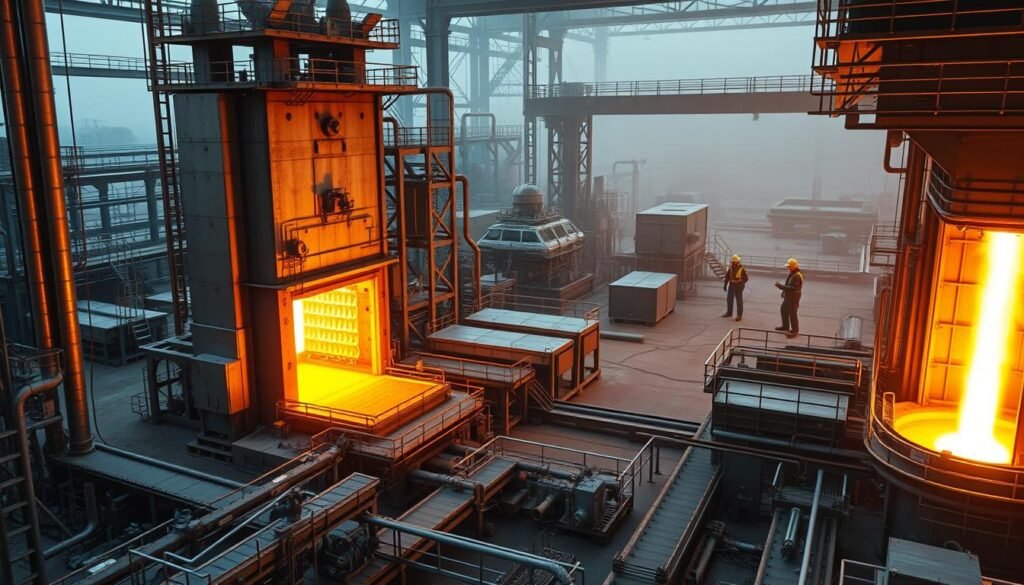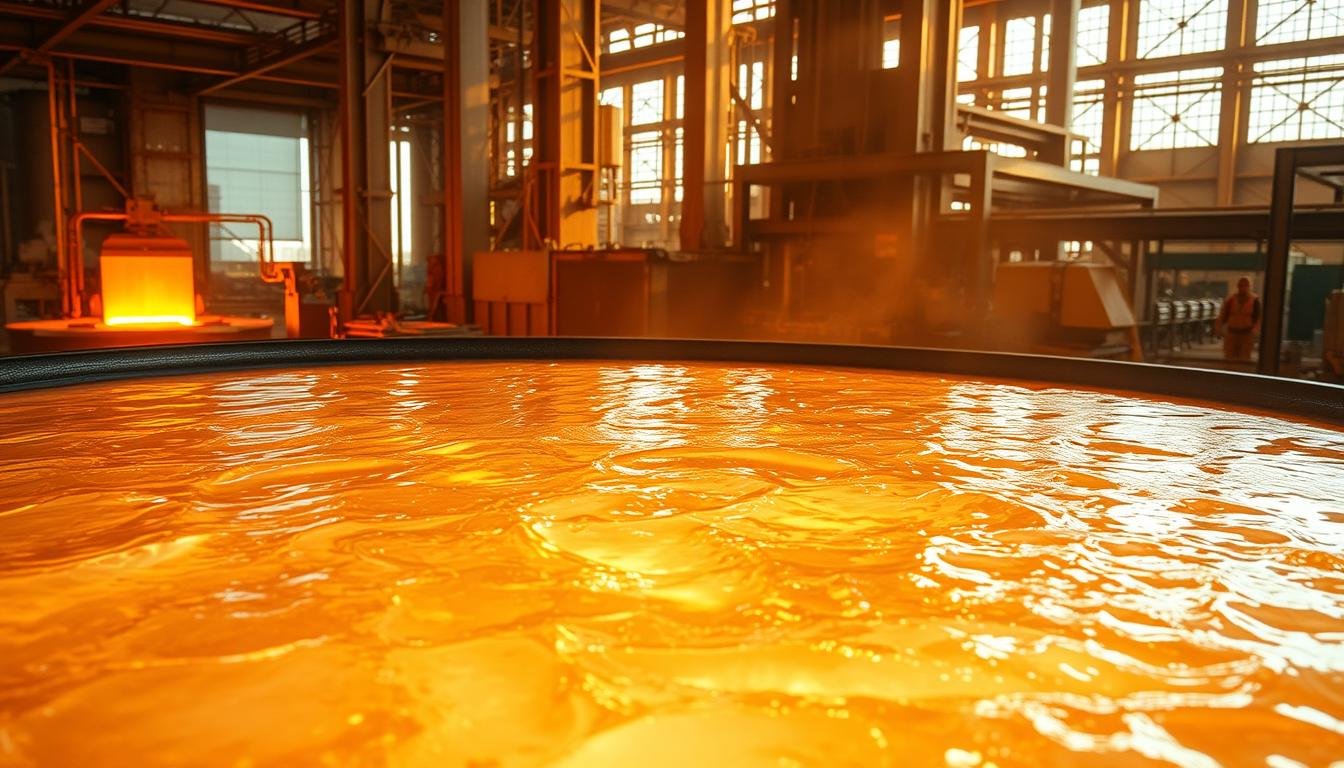From soda cans to aircraft parts, this lightweight metal shapes modern life. Its ability to transition from solid to liquid at 660°C (1220°F) makes it indispensable for manufacturing. Understanding this thermal threshold helps engineers select materials that balance durability with energy efficiency.
Metals behave differently under heat, and their phase-change temperatures determine industrial applications. The melting point of aluminum sits lower than steel but higher than plastics, creating unique opportunities for casting and recycling. Factors like purity levels influence this property, as detailed in resources on the science of metallurgy.
Why does this matter? Production methods like extrusion and welding rely on precise heat control. A moderate thermal threshold allows cost-effective processing while maintaining structural integrity. This balance explains why over 50 million metric tons are produced annually worldwide.
Upcoming sections explore how alloy blends and industrial techniques leverage this characteristic. For now, remember: knowing when materials change states unlocks smarter design choices across industries.
Introduction to Aluminum’s Melting Point
Once more valuable than gold, this element’s transformation revolutionized manufacturing. Its journey from mineral to metal began in 1886 with the Hall-Héroult process, which enabled efficient extraction from bauxite ore. Today, refinements in smelting have boosted efficiency by 20% since 2003, according to industry reports.
Historical Background and Development
Early metallurgists faced a unique challenge: the material exists naturally only in compounds like alumina. Isolating pure forms required electrolytic reduction, a method still central to modern refining. “The discovery reshaped material science,” notes a 2022 study on industrial metallurgy. Key milestones include:
| Year | Breakthrough | Impact |
|---|---|---|
| 1886 | Hall-Héroult Process | Enabled mass production |
| 1940s | Alloy Development | Expanded aerospace use |
| 2020s | Energy-Efficient Smelting | Reduced carbon footprint |
Significance in Modern Metalworking
Precise thermal thresholds allow engineers to balance strength and weight in designs. This property supports applications from skyscraper frames to electric vehicle components. Recycling processes further leverage its adaptability, melting and reforming it with 95% less energy than primary production.
Understanding phase transitions remains critical for sustainable manufacturing practices.
Advancements continue to refine how industries harness this material’s capabilities, ensuring its role in next-generation technologies.
Key Factors Affecting Aluminum Melting Point
Understanding what alters thermal thresholds in metals helps optimize industrial processes. Four primary variables shape this behavior: material blends, contaminants, environmental forces, and structural dimensions. Each plays a critical role in determining how materials respond to heat.
Alloy Composition and Its Influence
Combining metals creates tailored properties for specific applications. When mixed with elements like copper or silicon, the resulting blend behaves differently under heat than pure forms. For example, adding 10% magnesium can increase thermal resistance by 15%, while zinc additions often lower it.
Impurities, Pressure, and Temperature Effects
Contaminants as small as 0.1% can disrupt molecular structures. Iron or titanium traces typically raise transition temperatures, requiring adjusted processing methods. Pressure changes also have counterintuitive impacts:
| Pressure Level | Effect | Practical Example |
|---|---|---|
| Standard (1 atm) | Stable phase change | Traditional casting |
| High (3,500 GPa) | Reduced threshold | Advanced composites |
Particle Size and Additional Variables
Nanoscale materials melt faster due to increased surface exposure. Powders under 100 nanometers may transition at 40°C lower than bulk forms. This principle drives innovations in 3D printing and specialized coatings.
Pure Aluminum vs. Aluminum Alloys
Material engineers face critical decisions when choosing between pure and alloyed forms of this versatile metal. Thermal properties like melting points directly impact manufacturing outcomes, making these distinctions vital for quality control.
Temperature Variations in Different Forms
The pure form transitions at exactly 660°C. Alloyed versions show diverse thermal behaviors based on added elements. Common blends include:
| Alloy Type | Melting Range | Primary Use |
|---|---|---|
| Magnesium Blend | 540–640°C | Marine hardware |
| Magnesium-Silicon Mix | 570–630°C | Building materials |
| Zinc Combination | 600–660°C | Vehicle frames |
| Manganese Addition | 640–700°C | High-temperature tools |
Copper mixtures melt as low as 500°C, ideal for electrical systems. These ranges help manufacturers match materials to operational demands.
Identifying Impurity Effects on Melting Points
Deviations from 660°C often indicate contamination rather than intentional alloying. Iron traces typically raise thermal thresholds, while zinc lowers them.
“A 5°C shift can reveal compromised material quality,” states a Boeing metallurgist. “This data shapes our supplier vetting process.”
Labs use differential scanning calorimetry to pinpoint impurities. Consistent results ensure alloys meet strict industry specifications before entering production lines.
Industrial Applications Driven by Melting Temperature
Factories worldwide rely on precise thermal properties to shape materials for countless products. The ability to transition states efficiently enables cost-effective manufacturing across sectors. Let’s examine how specific industries harness these characteristics.

Casting and Molding Processes
Pouring molten material into molds remains one of the most economical production methods. Complex shapes for automotive pistons or cookware form quickly under controlled heat. This process reduces waste compared to machining solid blocks.
Key advantages include:
- Rapid prototyping capabilities
- High-volume output for consumer goods
- Minimal post-processing requirements
Aerospace and Electrical Applications
In aircraft design, lightweight durability is non-negotiable. Wing panels and engine mounts withstand extreme conditions while maintaining structural integrity. Over 60% of modern aircraft frames utilize specialized alloys.
The electrical sector benefits from efficient conductivity. Molten forms transform into cables powering cities. Unlike copper, these wires balance performance with affordability in grid systems.
“Thermal management dictates material success in high-stakes environments,” notes a SpaceX engineering report.
Manufacturing Techniques and Recycling Benefits
Balancing industrial production with environmental responsibility defines modern metalworking. Advanced methods leverage thermal properties to reduce waste while maintaining quality. This dual focus drives innovations in both primary extraction and material reuse.
Electrolysis, Smelting, and Process Optimization
Extracting pure metal from alumina requires specialized techniques. The Hall-Héroult method dissolves aluminum oxide in cryolite, lowering its transition temperature from 2000°C to 950°C. This energy-smart approach enables large-scale operations without extreme heat demands.
| Process Stage | Energy Use (kWh/kg) | Output Efficiency |
|---|---|---|
| Primary Production | 13–15 | 85% pure |
| Recycling | 0.3–1.5 | 99% pure |
Modern smelters recover 98% of process gases, cutting emissions. Real-time temperature monitoring ensures optimal furnace performance during reshaping operations.
Energy Efficiency and Recycling Advantages
Repurposing scrap requires 95% less energy than new production. Standard furnaces easily reach the 660°C threshold, making reuse accessible for small workshops and factories alike. “Every ton recycled saves 14,000 kWh,” highlights a 2023 Aluminum Association report.
Key benefits include:
- No quality loss through multiple reuse cycles
- Reduced mining needs for raw materials
- Lower greenhouse gas emissions versus virgin production
These sustainable practices position metalworking as a leader in circular economy solutions. Thermal management innovations continue driving efficiency gains across the supply chain.
Safe Aluminum Melting Procedures
Industrial facilities handling high-temperature materials require rigorous safety protocols to protect workers and equipment. Proper thermal management and contamination control form the foundation of secure operations in foundries and recycling plants.
Proper Handling of Molten Metal
Workers maintain material temperatures between 1,300–1,450°F to ensure consistent flow while minimizing energy waste. Protective gear remains mandatory during transfers:
| Equipment | Purpose | Standards |
|---|---|---|
| Face Shields | Prevent splash injuries | ANSI Z87.1 certified |
| Fire-Resistant Suits | Block radiant heat | NFPA 2112 compliant |
| Insulated Gloves | Enable safe tool handling | Withstand 2,000°F |
Regular equipment inspections prevent failures during critical pouring stages. Facilities must designate clear zones for molten material movement to avoid accidental contact.
Preventing Explosions and Workplace Hazards
Steam explosions occur when moisture interacts with heated metal. Even small water quantities can vaporize instantly, creating dangerous pressure spikes. Prevention strategies include:
- Pre-heating scrap to 250°F before processing
- Using desiccant systems in storage areas
- Implementing leak detection in cooling lines
“One cup of water in a furnace can expand 1,700 times – equivalent to 12 sticks of dynamite,” warns an Aluminum Association safety guide.
Emergency shutdown protocols and automated temperature sensors provide additional protection layers. Monthly drills ensure teams respond effectively to containment breaches or equipment malfunctions.
Understanding Alloying Elements and Their Effects
Engineers manipulate metal blends to achieve precise thermal characteristics. By adjusting chemical recipes, they create materials tailored for extreme environments or energy-efficient production. This balance determines performance in everything from jet turbines to smartphone casings.
High-Temperature Alloy Additions
Copper and manganese significantly boost heat resistance. These elements form stable compounds that maintain structural integrity under stress. Common aerospace alloys like 2024 (4.5% copper) withstand temperatures up to 635°C.
| Alloy Series | Key Elements | Melting Range |
|---|---|---|
| 2000 | Copper | 500–635°C |
| 3000 | Manganese | 640–655°C |
| 7000 | Zinc | 475–635°C |
Melting Point Depression in Alloy Systems
Silicon and magnesium create lower-temperature mixtures ideal for casting. A 12% silicon blend melts at 577°C, enabling energy-saving die-casting methods. This phenomenon allows complex shapes to form without excessive heat.
“Magnesium additions below 6% optimize corrosion resistance while maintaining workability,” explains a Ford Motor Company metallurgist.
Material scientists continually test combinations to balance thermal behavior with mechanical demands. These innovations drive advancements in sustainable manufacturing and lightweight design.
Conclusion
In modern engineering, thermal properties dictate material success across industries. The balance between heat resistance and structural integrity determines whether alloys meet demanding applications—from spacecraft components to sustainable packaging solutions. Understanding how elements like magnesium or silicon alter thermal thresholds remains vital for innovation.
Material scientists continuously refine metal blends to optimize performance. Factors such as impurity levels and pressure conditions prove critical during production phases. These adjustments enable manufacturers to achieve precise specifications while conserving energy.
Emerging technologies rely on these advancements. Aerospace systems utilize high-temperature alloys, while recycling processes leverage lower thermal requirements. Each application underscores the importance of tailored material science in driving progress.
Future developments will likely focus on eco-friendly production methods and enhanced alloy performance. By mastering thermal characteristics, industries can reduce waste and improve product lifespans. This knowledge forms the foundation for next-generation engineering breakthroughs.
